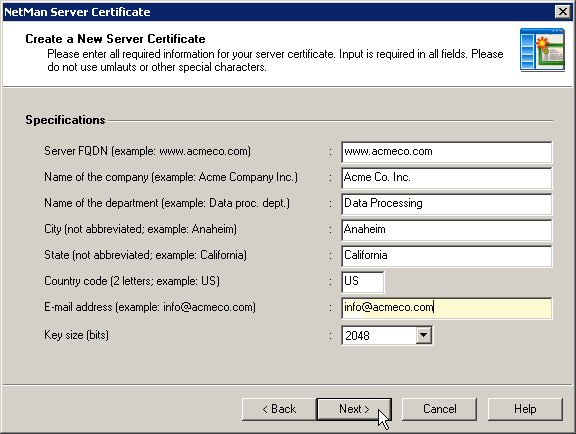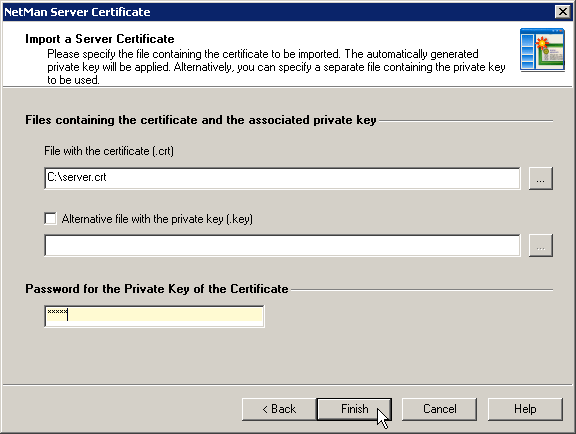Using an official server certificate involves two steps:
1.Requesting a certificate: You need to create a certificate request and send it to a certificate authority. The certificate authority checks the specifications of the request for correctness and issues the certificate.
2.Import the certificate: Once the certificate has been issued by the certificate authority, you need to import it to your server.
Creating a certificate request
Certificate requests are created in the Certificate Wizard. To run the Certificate Wizard, begin by opening the NetMan System Settings from the Windows Control Panel, under System and Security/H+H NetMan.
1. In the NetMan System Settings, select NetMan Web Service in the sidebar.
2. On the NetMan Web Service page, click on the Edit button under Certificates.
3. Select Create or request a new server certificate and confirm by clicking on Next.
4. On the Create a New Server Certificate page, enter all the data requested:

Server FQDN. Name of the server on which NetMan Desktop Manager is installed. This name has to match the URL that is entered in the browser to access the Web Interface. If the name in the Active Directory domain was acmecompany.local, for example, and the server was called rz2, you would enter rz2.acmecompany.local as the FQDN.
Name of the company. The name of your company or organization.
Name of the department. You can use this input to specify a particular department or section of your company or organization (for example, the data processing center).
City. The city in which your organization is located.
State. The state in which your organization is located.
Country code. Enter the two-letter code for your country (see ISO 3166; for example, US for the United States, UK for the United Kingdom, DE for Germany, etc).
E-mail address. Enter the e-mail address to be used for contact.
Key size (bits). The key size for the encryption of the certificate.
5. Click on Next. On the next page, indicate whether you are creating a self-signed certificate or a request for a certificate from an official certificate authority. Under Type of certificate, select the Create a certificate request for an official certificate authority option and enter a password to protect the private key:
6. Click on Finish to create and view the certificate request. To submit the certificate request to your certificate authority, you can copy and paste it into the web form at the CA website, or send a file containing the certificate request (by e-mail, for example). This completes the certificate request. When you receive the certificate from the certificate authority, proceed with the import procedure as described below.
Importing the certificate
Certificate requests are created in the Certificate Wizard. To run the Certificate Wizard, begin by opening the NetMan System Settings from the Windows Control Panel, under H+H NetMan.
1. On the NetMan Web Service page, under Certificates, click on the Manage certificates button to open the Certificate Wizard.
2. Select the Import a server certificate task and click on Next to continue:
3. On the Import a Server Certificate page, enter the file name of your certificate and the password for the private key:

![]() The Alternative file with the private key (.key) setting is not relevant unless the certificate file and private key were both created using other tools, rather than the NetMan Certificate Wizard.
The Alternative file with the private key (.key) setting is not relevant unless the certificate file and private key were both created using other tools, rather than the NetMan Certificate Wizard.
![]() The NetMan system expects the DER format for certificate files, requests and private keys.
The NetMan system expects the DER format for certificate files, requests and private keys.
4. Click on Finish to create the certificate and integrate it in the web server. Your changes will not take effect until after you restart the NetMan web server.
![]() To restart the web server, open the NetMan Web Service page of the NetMan System Settings and click on Restart in the Ribbon.
To restart the web server, open the NetMan Web Service page of the NetMan System Settings and click on Restart in the Ribbon.
For details on all of the NetMan System Settings, see "NetMan System Settings". For instructions on creating a self-signed certificate for testing purposes, see "Create a Self-Signed Certificate".